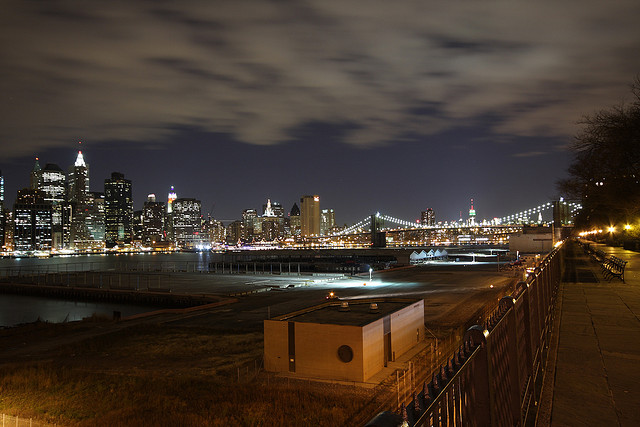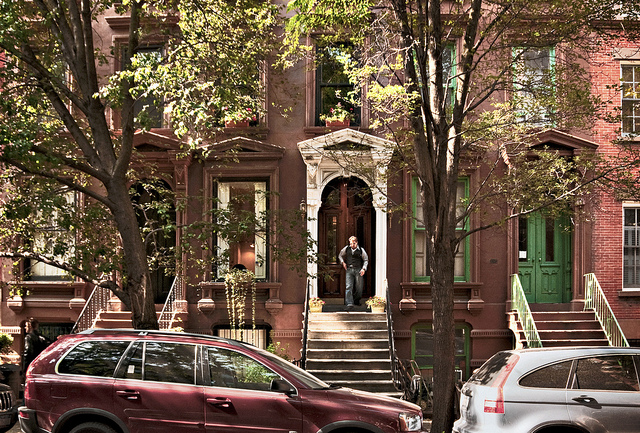 Throughout this year, several bloggers will engage in a conversation here and on their blogs — asking questions of each other and responding. Others are absolutely welcome to join the conversation, as well. Learn more about the ladies of Blogversation 2012.
Throughout this year, several bloggers will engage in a conversation here and on their blogs — asking questions of each other and responding. Others are absolutely welcome to join the conversation, as well. Learn more about the ladies of Blogversation 2012.
Today’s question is from your host — I’m @cnewvine on Twitter:
At first, I was offended when I heard comedian and actor Reggie Watts was talking smack about my neighborhood.
When I stopped being defensive, I thought more about what he said in an interview with College Times:
I use to live in Brooklyn Heights, and it was mainly just brownstones with kind of upper-middle class, a few white rich people and their ethnic nannies taking care of their white babies. There’s a lot of strollers going up and down the street with all these women that are obviously not the mothers of these children just walking around.
And then some kind of boring college students going to whatever university is there. It’s the most uninspiring place to live. If you’re an artist, never live in a family community, unless you draw inspiration from children and nannies. It’s just horrible.
(Many thanks to Brooklyn Heights Blog, whose Twitter account alerted me to Reggie’s insults.)

I realized that I agree with some of Watts’s objective statements — yes, Brooklyn Heights is a brownstone neighborhood with lots of well-off white families and their nannies, along with college students coming and going from St. Francis and Brooklyn Law School.
Where I take issue is his declaration that it’s uninspiring. I think like beauty, that’s a subjective assessment.
We moved to Brooklyn Heights after three years in Manhattan, where we lived across the street from Lincoln Center and Julliard and a five-minute walk from Jazz at Lincoln Center in the Time Warner Center. Our Manhattan apartment was in some ways in the center of the New York creative universe, but I didn’t really feel it. To me, the neighborhood felt cold, aimed mostly at tourists, and much of the creativity seemed aimed at people far wealthier than us.
Is that fact? No. That’s just how it felt to me. Others might’ve lived there and struck up deep, inspiring friendships with Julliard students practicing in Central Park, for example, or become regulars at the late show at Dizzy’s jazz club. We just didn’t.

Meanwhile, Brooklyn Heights makes my heart feel good.
We’re a 10-minute walk from the East River and a view of New York Harbor. I can take my laptop and sit on a bench in Brooklyn Bridge Park where I can smell the water and see the Statue of Liberty and Manhattan’s financial district.
Many of the blocks near us are lined with trees and well-tended brownstones with lush city landscaping, like overflowing window boxes and colorful pots on the stairs. We stroll the sidewalks of our neighborhood many evenings and while we still live in a vibrant urban neighborhood, where we can walk to grocery shopping, the dry cleaner, our dentist and the like, there’s a peacefulness at night that we didn’t get in Manhattan.
And yet, we do far more socializing on foot than we ever did in Manhattan. Last weekend, we went to brunch about a 15-minute walk from our apartment and while sitting at a sidewalk table, we saw an artist couple we’re friends with… our own Blogversationist Lesley Ware and her hubby Kamau! They sat with us then John texted another artist friend of ours, who arrived a few minutes later and shared a beer.
That kind of casual encounter didn’t happen for us in Manhattan. Could it have? Almost certainly. But it didn’t. The creatives we knew generally didn’t live on the Upper West Side, and we never made many friends in our immediate neighborhood.
I find the beauty of our neighborhood, the ease of living here and the creative friends nearby all inspiring.
So I’m not sure you can label a place “inspiring” or “uninspiring,” because so much of that is about the individual.
One person might find it profoundly inspiring to live in a cabin in the mountains miles from the nearest neighbor, while another would find that isolating and lonely. Reggie Watts finds it inspiring to live in Williamsburg, where John and I enjoy going out for music and food, but I think if I lived there, I’d quickly get irritated by the noise of the partiers and the parade of hipsters.
My question for this week: what do you want from your hometown or neighborhood? Has that changed over the years, either because you’ve changed or your neighborhood has changed?
Living in Williamsburg is inspiring to Reggie Watts, whose new Live In Central Park includes this absolutely NOT safe for work bit peppered liberally with the f bomb:
[youtube=http://www.youtube.com/watch?v=WQQCN0rgp58]
Related posts:


9 Comments
H.T. Riekels
Basically nothing is immune to some ridicule. I love where I live, but there is certainly a lot to make fun of. I wouldn’t have it any other way. It helps maintain objectivity.
Lesley Ware
I expect totally different things from my hometown (Muskegon, MI) and my current neighborhood (Bed stuy). Pondering…oh, my. Great conversation question…
Eleanor
The first thing that comes to mind is opportunities to connect. I love talking to my neighbors, even if it’s just sitting on the stoop and saying Hello. There’s several ladies who I have coffee with in the morning at the bagel shop. The second thing is opportunities to have fun and enjoy life. I love walking around and enjoying the physical landscape here in Carroll Gardens. Treats Truck – yay! Carroll Park with the Sunday Times and my fella – yay! I’m fortunate enough now to have a job where I get to know my neighborhood even more; I am the BoCoCa Neighborhood Organizer for GO, a community-curated open studio project of The Brooklyn Museum.
Jennifer Worick
More sunshine and less passive-aggressiveness. Guess where I live? I pondered this question at http://jenniferworick.blogspot.com/2012/06/blogversation-what-do-you-want-from.html
Amy Throndsen
This question struck a chord with me and I haven’t been able to put down my thoughts into words. (I’m not sure this post does them justice either, but I wanted to comment!) I’ve followed my heart and my dreams moving almost every year for the last 10 years. I’ve met amazing people, and seen the sun rise and set in far off lands I never imagined I’d ever live. Since college, the longest I’ve lived somewhere was during my Peace Corps Service in China. It was in China that I developed a sense for place. I was so aware of my surroundings, and I realized that even though I couldn’t always communicate with language a smile, soft eyes, holding the door open, helping a kid up from the ground, walking slowly and not being in a rush … all helped me “fit in.”
I’ve been back in the US for almost 3 years. I spent the first 2 in DC in the international development field and, after joining my family’s business, it was clear I needed to move closer to home. I’ve been in Madison, Wisconsin almost a year. I’ve tried to use what I learned in China to help me “fit in” to my place in Madison. I’ve unpacked my bags, bought furniture for the first time in my life and hung the art work I’ve collected on my walls. I am making a home in Madison — in my space and place — by holding doors open, becoming a “regular” at a Belgium and Irish bar on my street, walking slowly to the grocery store, biking around the neighborhood, inviting friends over for dinner, visiting old professors at my college (just down the street) and getting involved with neighborhood events.
I’m honeymooning now with my place and I’m sure there will be times of disgust, but I’m trying to lay a foundation of positive memories, strong relationships and a loving atmosphere.
Colleen Newvine Tebeau
Amy, I’m glad you took the time to ponder this one — your experience of home is so interesting, in that you learned about home halfway around the world and are now applying those lessons having moved back to Wisconsin. I wonder if you’d have the same appreciation for intentionally building your sense of community if you’d never left?
get dropbox space by uploading photos
I am in fact happy to read this website posts which carries lots of helpful information,
thanks for providing these kinds of data.
Leave a reply